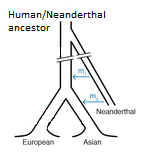Neanderthals were our cousins who lived in Europe from 600,000 to ~30,000 years ago. Despite being quite different from us there were enough genetic similarities to make interbreeding possible. And palaeolithic humans, in turn, shared a surprising number of similarities with rednecks, so gave it a go with our species’ cousins. As a result of that most non-Africans have between 1-3% Neanderthal DNA in their genome1. But is anything we inherited from the Neanderthals useful?
A report published yesterday in Science has revealed that we did inherit some beneficial genes from Neanderthals, including genes that influence our skin colour. They examined the genomes of over 600 people from Europe and East Asia and found that several of their Neanderthal genes had undergone positive selection. The two researchers, Vernot and Akey, also found that whilst each individual may only have 1-3% Neanderthal, when combined humans have a whopping 30% of the Neanderthal genome in them1. Albeit spread out into lots of little pieces, almost like we’re torrenting their genome. Don’t tell the oogity boogity we’re trying to take his intellectual copyright! They also found that this spread of genes couldn’t be explained by one bout of interbreeding between us and Neanderthals. There had to have been at least 2: one before Europeans and East Asians became different populations, and one in East Asians just after they did.
Vernot and Akey examined this 30%; looking for genes with a low number of alleles in Europeans relative to East Asians (and vice versa). Most genes have variants that do essentially the same thing, known as alleles. However, if one allele is beneficial then natural selection will spread it through the population at the expense of other alleles, until it is the only (or one of the few) variants for that gene that remain. Looking for such genes amongst the bits of Neanderthal we inherited revealed 4 regions which seem to have undergone positive selection1. These regions contained 10 or so genes which stood out; the names of which I won’t bother to repeat here as they’re all seemingly random collections of letters and numbers. However, if you are the sort of person for whom things like SEMA6D mean something, follow this footnote2.
The two researchers highlight two of these genes as appearing to have been especially important to humans: BNC2 and POU2F3, both of which appear to have been positively selected for in Europeans. The latter is involved with the production of keratin in the skin, although I don’t know exactly what as the literature on the subject is quite dense3. I do know that the keratin in the skin is part of what makes it a barrier to disease; but beyond that my google-fu is not strong enough to find out more.
BNC2 on the other hand is linked to skin pigmentation, influencing the saturation of skin colour. Different forms of the gene can give someone olive-coloured skin, pale white skin and anywhere in between4. Skin colour influences the amount of UVB light from the sun our skin absorbs. We need to absorb some in order to produce vitamin D, but too much can cause damage. As such it’s a bit of a balancing act and it’s easy to see how a set of genes which help refine skin tone would have been useful as the ancestors of Europeans travelled further north (where there is less sun) than ever before. Perhaps it might also indicate the range of skin colour present in Neanderthals.

Skin colour with different levels of hue and saturation. The latter appears to be controlled by a gene Europeans inherited from Neanderthals
It would be a bit of an oversimplification to say we inherited pale skin from Neanderthals as there are many genes involved with that; not all of which come from Neanderthals. However, Neanderthal genes did change the saturation of our skin, which proved very beneficial to Europeans. They also did something with keratin.
And I think it’s quite cool that many of us carry a trace of our extinct relatives in our skin.
References
- Vernot, B. and Akay, J. 2014. Resurrecting Surviving Neandertal Lineages from Modern Human Genomes. Science, DOI: 10.1126/science.1245938
- Genes they picked out but which did not discuss in the body of the text are SGCB/SPATA 18, SEMA6D, KRT6A/KRTS, PDE6C/FRA10AC1, RNF34/KDM2B and SIPA1L2
- Cabral, A., Fischer, D. F., Vermeij, W. P., & Backendorf, C. (2003). Distinct functional interactions of human Skn-1 isoforms with Ese-1 during keratinocyte terminal differentiation. Journal of Biological Chemistry, 278(20), 17792-17799.
- Jacobs, L. C., Wollstein, A., Lao, O., Hofman, A., Klaver, C. C., Uitterlinden, A. G., … & Liu, F. (2013). Comprehensive candidate gene study highlights UGT1A and BNC2 as new genes determining continuous skin color variation in Europeans. Human genetics, 132(2), 147-158.




“almost like we’re torrenting their genome” haha that is a marvelous expression and I intend to use that in conversation every chance I get
Pingback: Neanderthal genes harmed humans | EvoAnth
Pingback: Decoding the Stories of Our Ancestors pt. 2 | Thought and Awe
Pingback: Skin, hair and eye colour still evolving as recently as 4,000 years ago | EvoAnth
Pingback: Ancient DNA reveals how often and when humans & neanderthals interbred | EvoAnth